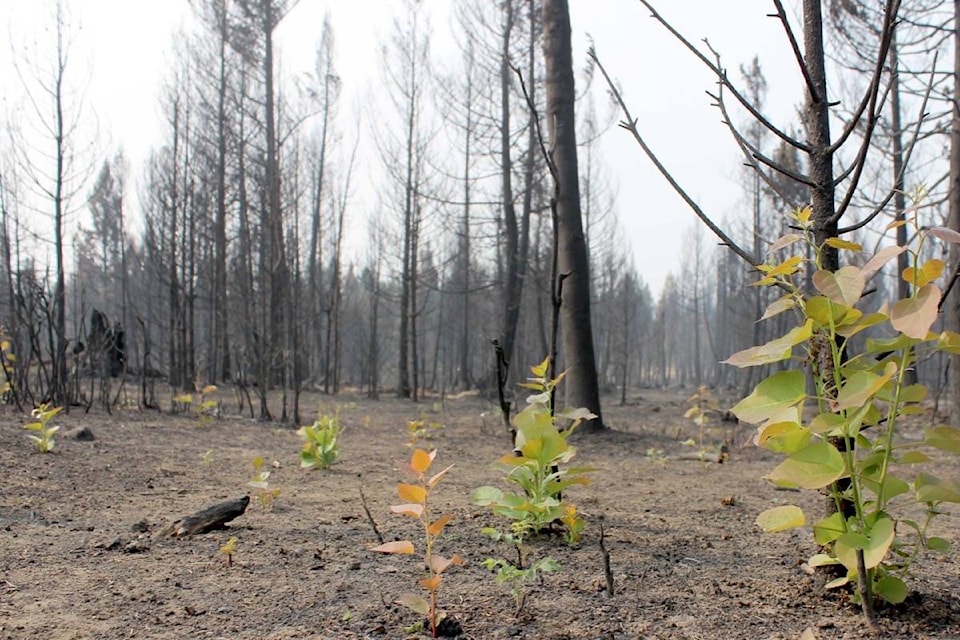On the Gustafsen fire, there’s still stuff coming up every day says Paul Wandler, the Incident Commander, but there is some positive news as well.
“We’ve initiated a bunch of rehab already. I know they’re looking at starting to sell the wood, starting to develop timber sales. There is some work to do though.
Fire Information Officer Heather Rice says there’s a lot of things they have to look at.
“There’ll already be someone on that fire walking around assessing the entire area, whether it’s for danger trees or the guards that have been put in, on private property, mind you most property owners might have to assess it themselves, but then we help them work through that and then a plan is put into place on how we do the rehabilitation of a fire.”
The rehabilitation officer on the Gustafsen fire started a few weeks ago and part of this rehabilitation often includes recontouring the guard and reseeding it, according to Rice, especially, in an area where cattle typically graze.
One big concern in the Cariboo is noxious weeds, says Assistant Fire Information Officer Terry Murphy.
“When they do the rehab… that’s a big goal to get the grass growing quick so that the weeds don’t come out.”
“Generally, they try and replant with the same species for the area so you’re not going to get a whole bunch of Birch trees all of a sudden in the middle of a forest.”
They might not get a chance to start a lot of it until the spring because with fires this size, they often won’t be considered out until the snow hits it and gets all those tiny little hotspots that are underneath the roots of trees, says Rice.
“It can stay hot for a long time unless we get some rain. Even Gustafsen will stay hot for a long time until we get some significant rain or snow.”
Sometimes the trees burned in a fire can also still be salvageable for logging purposes, they’ll put out tenders or put them up for sale, says Rice. After logging, they’ll replant it and manage it until it’s free to grow, says Rice, adding that it’s a benefit for rehabilitation.
“It happens faster. If we can remove all that dead and damaged wood and then go in and replant that generally reforests an area faster than natural regeneration.”
Sometimes growth will come back too thick, requiring them to go back to space it out and manage it, says Rice. Steeper slopes will often require some extra assessment, she says.
“Those would be a higher priority on steep slopes especially if they put in some guards on steeper areas because that will be more impacted with fall rains and stuff if it isn’t at least contoured. You might not get around to doing everything we want but they’ll certainly look at that. That’s often one of the first things they look at as far as safety because after an area is burned and the trees are all removed, it doesn’t absorb the rain as well so the rain might rush off those sites quicker and cause erosion.”
Once the fire has gone through the soil can become hydrophobic and won’t absorb water until the new stuff punches through, says Murphy, adding that in the Kelly Lake fire area, for example, that resulted in a lot of mudslides.
“The ground wasn’t taking the rainwater, it would just send it straight down to our ditches.”
How hot the fire burned will have a big impact on what it will look like, says Rice.
“If it burns really really hot in areas, like it did with Barriere along that hillside, the soils can actually be severely damaged too and then it’s incredibly difficult to reforest. That’s when you almost have to let nature run its course and the rehabilitation can take much longer because we can’t replant.”
The flat areas tend to not be as bad but the steep areas can burn hotter, says Rice.
“It won’t look great for a little while but it is amazing even the following spring if you walk through a fire where it’s safe to do so how quickly the smaller green plants start to come up and recover.”
